Masturbation Addiction: How it Happens? Signs, Symptoms
You’re not alone if you’ve ever wondered: “Am I addicted to masturbation?”
For many young men, this question creeps in late at night, after another moment of guilt, secrecy, or frustration.
It’s confusing because by the time masturbation starts to feel compulsive, as it interferes with your goals, your focus, or your relationships, it can feel overwhelming.
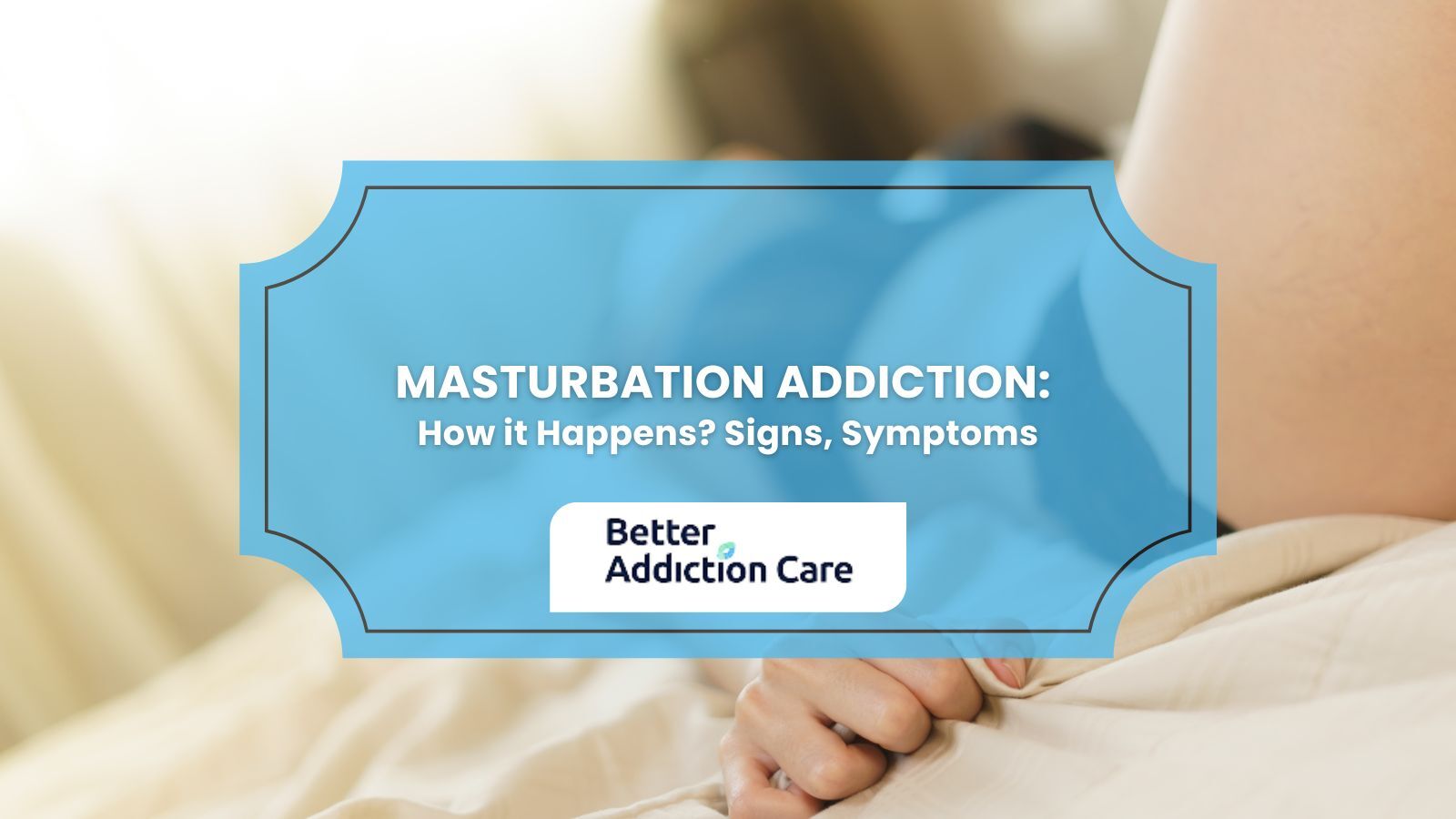
Masturbation addiction isn’t always openly talked about. Shame, cultural silence, and myths make it harder to know what’s really happening.
But understanding how this Behavioral addiction develops, and what signs to watch for, is the first step toward breaking the cycle and regaining control.
The answer to addiction is:
Masturbation addiction, technically classified under ICD-11 as Compulsive Sexual Behavior Disorder (CSBD), occurs when intense and repetitive sexual urges persist for at least six months, despite causing distress or impairment in social, academic, or personal functioning[1].
It goes beyond frequency: it’s about loss of control, persistent preoccupation, and continuing the behavior despite harmful consequences[2].
Key Takeaways
- Masturbation addiction is more than frequency—it’s about loss of control. When urges become compulsive, interfere with daily life, and cause guilt or distress, it signals a behavioral addiction that deserves attention and care.
-
Understanding the cycle makes recovery possible. Biological, psychological, and environmental factors all play a role, but recognizing triggers and the “relief → guilt → repeat” loop helps young men take the first step toward breaking free.
-
Support is available, and you don’t have to face it alone. From professional therapy to confidential helplines and support groups, evidence-based resources exist to guide healthier coping strategies and restore balance in relationships, confidence, and daily functioning.
Masturbation Addiction: An Overview
In behavioral health terms, masturbation addiction is best understood through the lens of Compulsive Sexual Behavior Disorder (CSBD), a diagnosis included in the World Health Organization’s ICD-11[1].
It refers to a persistent inability to control sexual urges or behaviors—specifically masturbation—over a period of months, leading to distress or problems in daily functioning.
It’s important to distinguish addiction from habit or high frequency alone. Some young men may masturbate often without experiencing disruption to their goals, relationships, or mental health.
Masturbation addiction, however, involves loss of control, preoccupation, and continuing the behavior despite harm, setting it apart from mere frequency.
Recognizing this distinction early matters.
-
For young men, catching the signs of compulsive behavior before it spirals can reduce shame, prevent worsening cycles of secrecy and distress, and make recovery much easier.
-
The earlier the pattern is identified, the more effective and supportive interventions can be.
When Does It Cross into Addiction?
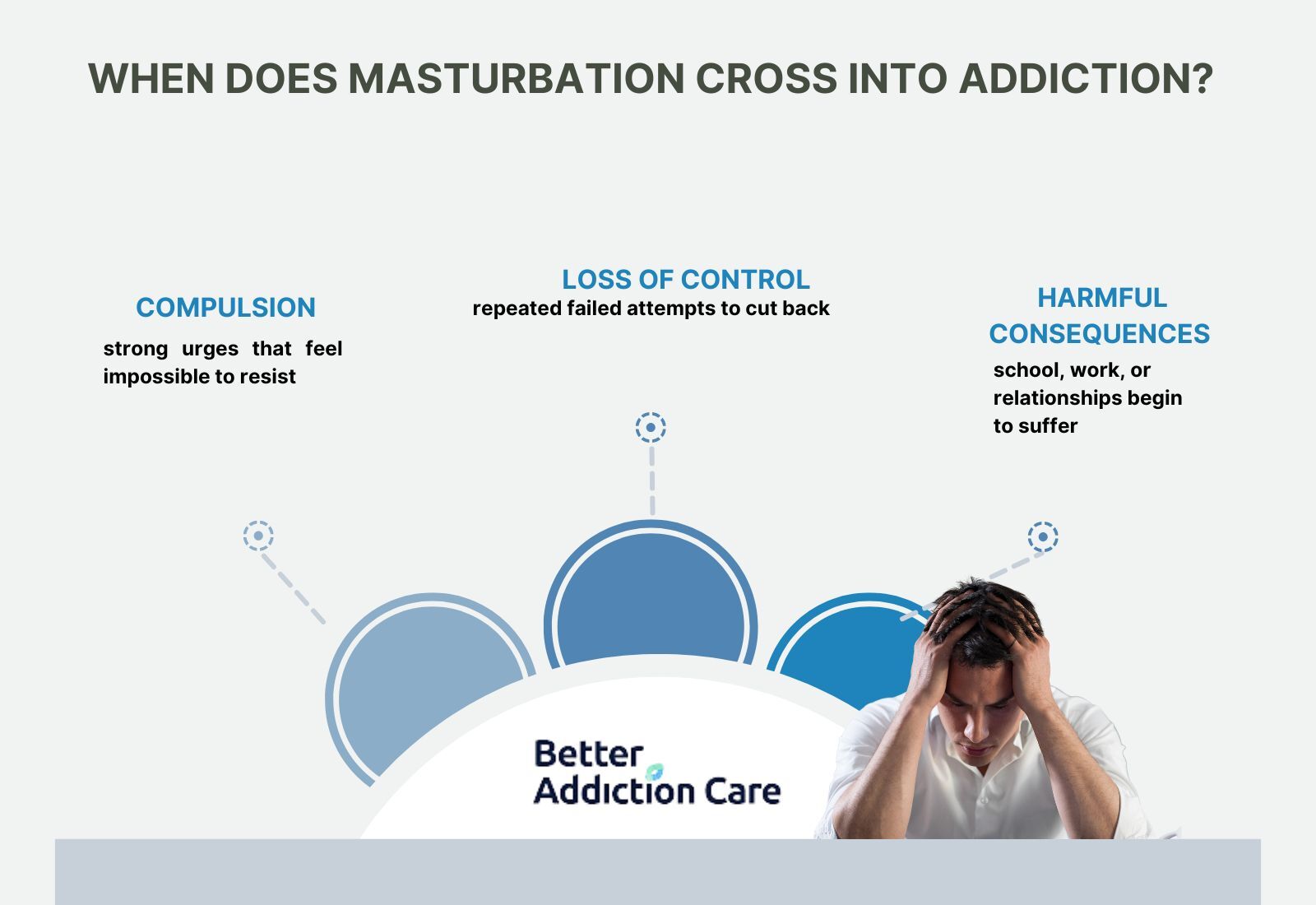
Masturbation becomes an addiction when three things show up together:
-
Compulsion – strong urges that feel impossible to resist
-
Loss of control – repeated failed attempts to cut back
-
Harmful consequences – school, work, or relationships begin to suffer[1][2][6]
It’s not about how often someone masturbates. Some people engage frequently without distress, while others feel trapped in a cycle of urges, guilt, and relapse[3][5]. The difference lies in whether the behavior is still a choice—or if it has taken over.
Red flags include:
-
Constant preoccupation and distraction
-
Needing riskier situations or more porn to achieve the same relief
-
Hiding behavior, leading to secrecy and isolation[4][6]
Frequency doesn’t equal addiction. Addiction begins when masturbation consistently overrides control, disrupts life, and keeps repeating despite negative consequences[1][5][6].
How Masturbation Addiction Develops?
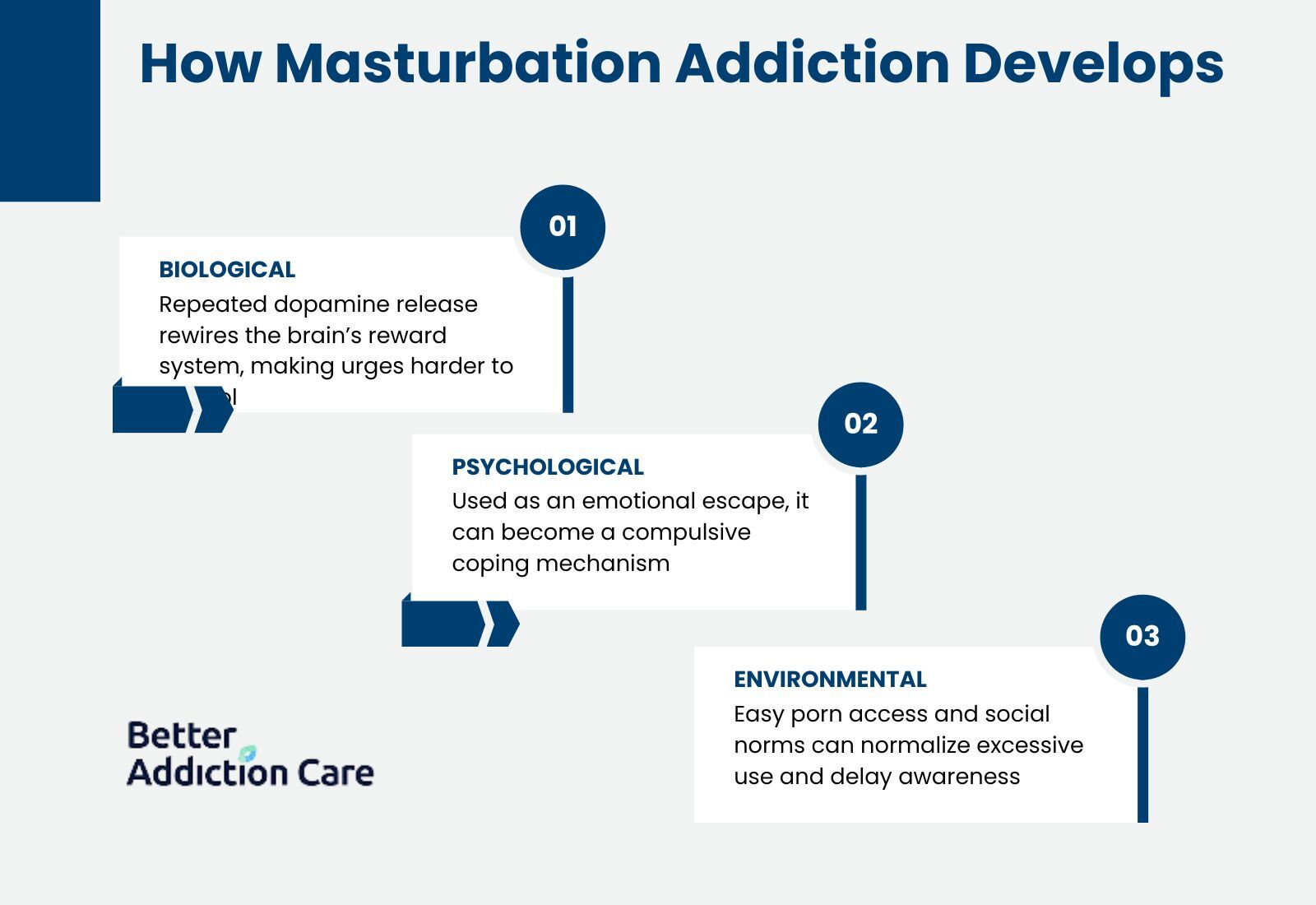
Masturbation addiction does not appear suddenly—it usually forms through an interaction of biological, psychological, and environmental influences that reinforce compulsive patterns over time.
1. Biological Pathways: Brain Reward and Dopamine
Masturbation activates the brain’s reward system, releasing dopamine and other neurochemicals tied to pleasure and reinforcement[2].
For some young men, repeated overstimulation of this pathway can lead to a cycle where the brain increasingly “expects” the behavior for reward, making urges stronger and harder to resist.
Over time, the prefrontal cortex—the part of the brain responsible for decision-making and self-control—struggles to regulate these impulses.
2. Psychological Factors: Stress, Anxiety, and Emotional Regulation
Many individuals turn to masturbation as a coping mechanism for stress, loneliness, boredom, or unresolved emotional challenges[3].
When it becomes the primary way to manage negative emotions, the behavior shifts from a voluntary choice to a compulsive reliance.
Feelings of guilt or shame that follow can further reinforce the cycle, creating what behavioral health experts call a negative reinforcement loop.
3. Environmental and Social Influences
Easy access to internet pornography, lack of sexual education, and secrecy around sexual health can accelerate the development of compulsive masturbation[4].
Young men may also normalize the behavior through peer conversations or online culture, making it harder to recognize when a private habit is crossing into addictive territory.
Why Understanding Development Pathways?
Seeing how biology, psychology, and environment interact highlights that masturbation addiction is not just a matter of “willpower.”
It has real behavioral health roots, and that perspective reduces stigma while pointing toward effective recovery strategies.
Signs and Symptoms of Masturbation Addiction
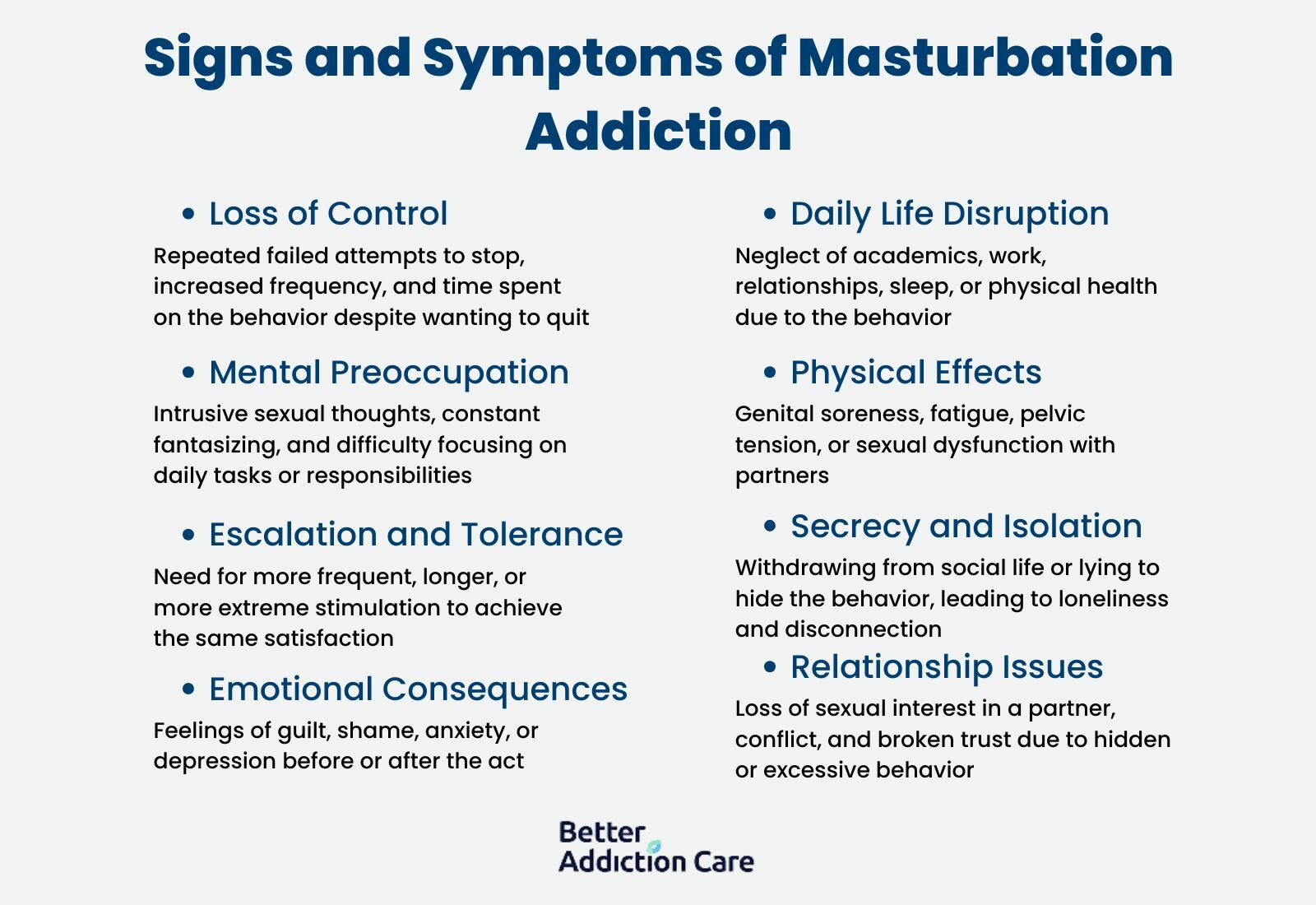
Masturbation addiction can be difficult to recognize at first because the behavior is private, socially stigmatized, and often hidden.
For young men, secrecy or denial may make it even harder to identify when a personal habit has shifted into an unhealthy compulsion.
However, certain behavioral, emotional, and physical signs consistently appear when masturbation has crossed the line into addiction.
1. Loss of Control
One of the defining features of behavioral addiction is the inability to control urges. A young man may decide he will reduce or stop the behavior, but finds himself returning to it repeatedly. This can include:
-
Unsuccessful attempts to cut down despite motivation to do so.
-
Increasing frequency or intensity of the behavior over time.
-
Spending more time than intended on masturbation or related activities, such as pornography consumption.
Loss of control is often accompanied by feelings of frustration or self-blame, which can worsen the cycle of compulsivity.
2. Preoccupation and Mental Intrusion
Another hallmark sign is persistent mental preoccupation with the behavior. This might show up as:
-
Constant fantasies or planning around when the next opportunity will occur.
-
Difficulty focusing on studies, work, or conversations because of intrusive sexual thoughts.
-
Choosing to stay isolated or avoid social situations to create private time for masturbation.
The National Institute on Drug Abuse notes that compulsive behaviors—including sexual compulsivity—share neurobiological similarities with substance cravings, hijacking attention and decision-making processes[5].
3. Escalation and Tolerance
Similar to substance addictions, individuals may develop tolerance, where the same level of stimulation no longer provides the same satisfaction. This can lead to:
-
More frequent sessions per day.
-
Longer sessions to achieve release.
-
Seeking out increasingly novel or extreme stimuli (e.g., pornography genres) to maintain arousal.
This escalation can become exhausting, both physically and mentally, but it feels difficult to resist.
4. Negative Emotional Consequences
Addiction often thrives in the tension between short-term relief and long-term harm. For masturbation addiction, the emotional toll may include:
-
Shame and guilt, particularly in cultures or families where the behavior is heavily stigmatized.
-
Anxiety or depression, either as triggers or as consequences of compulsive use.
-
Feelings of emptiness or regret immediately after the act, creating a cycle of emotional highs and lows.
SAMHSA emphasizes that behavioral addictions often co-occur with mental health conditions like depression and anxiety, creating reinforcing cycles of distress and compulsivity[6].
5. Interference with Daily Functioning
One of the clearest signals that masturbation has crossed into addiction is functional impairment. This means the behavior is interfering with important areas of life, such as:
-
Falling behind on academic work, job responsibilities, or sports training due to lost time or fatigue.
-
Neglecting friendships, relationships, or family responsibilities.
-
Disrupted sleep patterns from late-night sessions.
-
Risking privacy at school, work, or public spaces to satisfy urges.
Behavioral health experts emphasize that addiction is not defined by the act itself but by its impact on functioning. When private behavior begins to erode opportunities, relationships, and self-confidence, it signals a deeper problem.
6. Physical Consequences
Though often overlooked, the body can also show strain from compulsive masturbation. Possible physical signs include:
-
Genital soreness or skin irritation.
-
Pelvic pain or tension.
-
Fatigue or weakened energy due to overexertion.
-
Disrupted sexual response with partners, such as difficulty achieving arousal or orgasm (sometimes called “porn-induced erectile dysfunction”).
While not all young men experience these consequences, repeated strain without recovery can contribute to physical distress and compound emotional shame.
7. Secrecy and Isolation
Because masturbation addiction is deeply private, many young men develop patterns of secrecy that isolate them further. This might include:
-
Lying to family members, partners, or friends about time spent alone.
-
Avoiding group living situations (e.g., dorms, roommates) to preserve privacy.
-
Withdrawing socially to maintain access to pornography or masturbation routines.
This isolation not only worsens mental health but also cuts individuals off from the very support networks that could help break the cycle.
8. Relationship Strain
For men in relationships, masturbation addiction can have ripple effects on intimacy and trust. Common issues include:
-
Reduced interest in real-life sexual intimacy due to overstimulation from pornography or solo activity.
-
Conflict with partners who feel neglected or betrayed.
-
Erosion of trust if the behavior is hidden or minimized.
SAMHSA notes that behavioral addictions often spill into family systems, straining trust and communication in ways that amplify the individual’s shame and secrecy[6].
Psychological and Social Impact
Masturbation addiction doesn’t only affect the individual in private.
Its consequences extend into self-image, relationships, and social life, shaping how young men view themselves and interact with the world.
Erosion of Confidence and Self-Image
Compulsive patterns are frequently followed by guilt, shame, or frustration. These emotions accumulate, gradually undermining confidence and self-worth. Many young men describe feeling “weak” or “out of control,” which deepens negative self-beliefs and fuels anxiety or depression [2][3][5].
-
Emotional distress makes it harder to maintain motivation.
-
Persistent shame discourages reaching out for help.
Relationship Challenges and Intimacy Issues
Addiction can disrupt both romantic and sexual connections. When masturbation becomes the primary outlet—particularly if paired with excessive pornography use—the following issues often arise:
-
Reduced arousal or interest in real-life intimacy
-
Sexual dysfunctions, such as delayed ejaculation
-
Emotional distance from a partner due to secrecy or dishonesty
These difficulties can create frustration on both sides, erode trust, and make it harder to build healthy, long-term intimacy[4][5].
Withdrawal and Social Isolation
Secrecy is another defining feature. Many men hide their behavior, fearing stigma or judgment. As a result, they withdraw from family, friends, or social circles.
-
Time that could be invested in studies, work, or hobbies is consumed by the compulsion.
-
Loneliness increases, which then triggers even more reliance on the behavior.
This cycle reinforces both the addiction and the sense of isolation[6].
Do These Impacts Matter for Recovery?
The psychological and social consequences often become the tipping point that motivates individuals to seek change. While the act itself may be private, the ripple effects—low self-esteem, strained relationships, and growing isolation—are impossible to ignore.
Recovery, therefore, is not only about reducing the behavior. It is also about restoring balance, self-confidence, and human connection[1][2][6].
The Cycle of Compulsion: Why It’s Hard to Stop?
For many young men, masturbation addiction isn’t about a lack of willpower. It’s about being caught in a loop that keeps pulling them back in — even when they want to stop.
Common Triggers That Start the Cycle
-
Stress or anxiety after a tough day
-
Loneliness or boredom when nothing else feels engaging
-
Habitual cues like being online late at night or scrolling adult content
These moments become automatic “go signals,” setting the cycle in motion.
The Relief → Guilt → Repeat Loop
The pattern often looks like this:
-
Urge builds → A strong craving develops.
-
Release brings relief → Tension drops, stress feels temporarily managed.
-
Guilt and shame follow → Thoughts like “Why can’t I stop?” create more distress.
-
Another urge rises → To numb the guilt, the cycle begins again.
Over time, this loop strengthens itself — making stopping harder without support.
How the Brain Reinforces It?
Each release activates the brain’s reward system. Dopamine floods in, teaching the brain: “This is how we cope.”
-
The more the cycle repeats, the stronger the “wiring” becomes.
-
Relief is short-lived, but the craving grows sharper.
-
Without new coping tools, the brain defaults back to the same behavior.
Why Breaking the Cycle Feels So Difficult?
When this pattern repeats daily or multiple times a day, it can:
-
Crowd out healthier coping skills
-
Build frustration and self-doubt
-
Make young men feel “trapped” even if they want to change
Recognizing this loop early matters. Once you see the pattern for what it is — a conditioned cycle — it becomes easier to imagine a path out with the right strategies and support.
Potential Long-Term Risks if Left Unaddressed
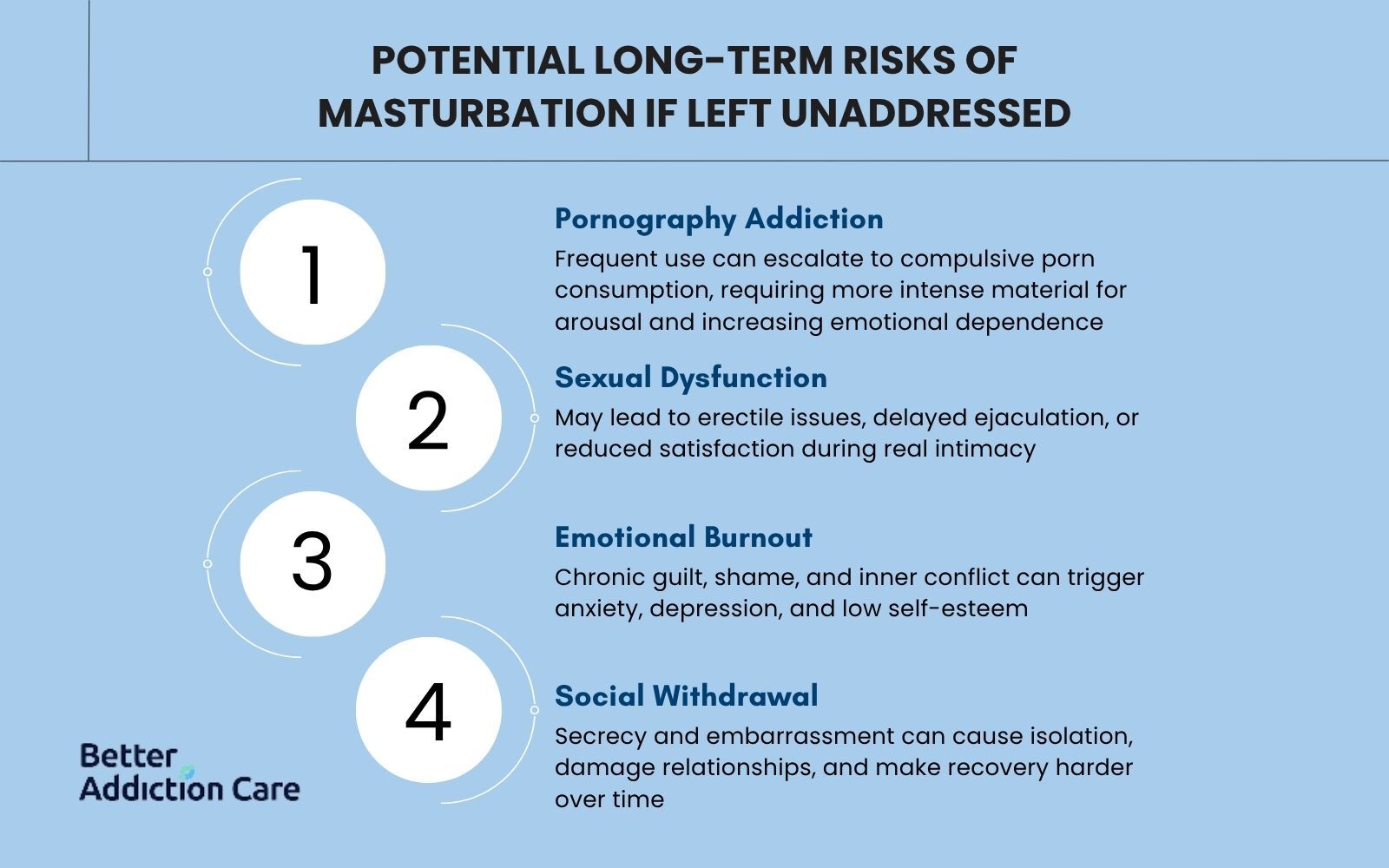
Masturbation addiction, when left unchecked, can quietly intensify over time.
What might begin as a way to manage stress or escape boredom can grow into patterns that affect sexual health, relationships, and emotional well-being.
Escalation Toward Pornography Addiction
Many young men caught in compulsive cycles turn to pornography more frequently. Over time, the brain adapts, seeking stronger or more novel material to achieve the same level of arousal.
This escalation increases the risk of crossing into pornography addiction, which carries its own challenges for intimacy and mental health.
Sexual Dysfunction
Research has linked compulsive masturbation and excessive porn use with:
-
Erectile problems — difficulty becoming aroused with a partner, despite stimulation from screens.
-
Delayed ejaculation — needing prolonged stimulation to climax, which can interfere with natural intimacy.
-
Loss of satisfaction — sexual experiences may begin to feel dull or unfulfilling outside of compulsive habits.
These dysfunctions are not guaranteed, but they are reported with enough consistency to be taken seriously.
Emotional Burnout
The cycle of brief relief followed by guilt or shame can create lasting emotional strain. Over months or years, this may build into:
-
Persistent anxiety about one’s sexual health.
-
Lowered mood or even depressive symptoms.
-
A sense of exhaustion from constant internal conflict.
Worsening Isolation
Another risk lies in withdrawal from others. Some men begin avoiding social opportunities or intimacy out of embarrassment, choosing secrecy over openness. Left unaddressed, this can damage confidence and make recovery feel more daunting.
Why Early Action Matters?
These risks highlight an important truth: masturbation addiction is not only about “doing it too much.”
It’s about how the behavior reshapes emotional patterns, brain responses, and social life. Recognizing the problem early creates a better chance to reverse these effects before they take hold.
Conclusion
Masturbation addiction is not about occasional private behavior—it’s about when the urge takes control, interferes with daily life, and causes distress.
For young men, recognizing the cycle early can prevent long-term consequences like intimacy struggles, anxiety, or even sexual dysfunction.
The good news is that recovery is possible.
By understanding how biological, psychological, and environmental factors fuel compulsive behavior, you can start to break the cycle with awareness and support.
FAQs Related to Masturbation Addiction
Yes. While it isn’t officially classified in the same way as substance use disorders, behavioral addictions like compulsive gambling and gaming are recognized by mental health professionals. Treatment often includes cognitive-behavioral therapy (CBT), mindfulness strategies, and, in some cases, medication to manage co-occurring issues such as anxiety or depression.
Relapse is common in any form of addiction recovery. Instead of viewing it as failure, it’s better to see relapse as feedback—showing where more support or coping strategies are needed. Working with a counsellor or joining support groups can make recovery more consistent.
If compulsive masturbation is disrupting daily responsibilities, causing distress, or harming relationships, professional help is recommended. A therapist who specializes in sexual health or behavioral addictions can provide confidential guidance and a tailored recovery plan.
Yes. Confidential hotlines, online therapy platforms, and anonymous support groups make it easier to get help without fear of judgment. The Substance Abuse and Mental Health Services Administration (SAMHSA) offers a free, confidential helpline in the U.S. that can guide people toward local resources.
Some men report temporary changes—such as irritability, mood swings, or trouble focusing—after stopping suddenly. These usually improve over time as the brain adjusts. Building healthier coping habits helps make the transition easier.
Yes, in some cases. Overstimulation from pornography or compulsive habits can reduce sensitivity and make arousal with a partner more difficult. This is sometimes reversible with reduced use and healthier habits.
Some men improve by setting limits, finding accountability partners, or replacing the behavior with healthier outlets like exercise. But if the cycle feels unmanageable, professional support can make recovery more effective.
Recovery varies. Some notice changes in a few weeks, while others need several months of consistent effort. The key is persistence—slip-ups don’t erase progress.
Yes. Many find strength in spiritual practices, community support, or cultural guidance. These resources can provide meaning, accountability, and encouragement alongside behavioral strategies.





